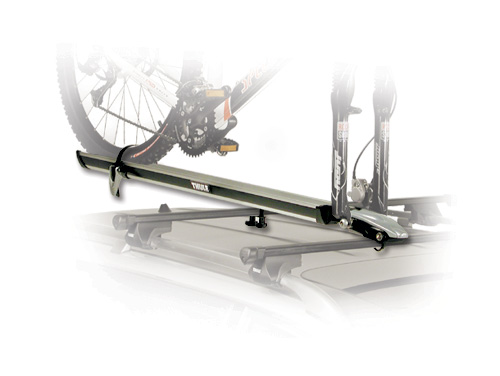Arcata, California-based Yakima has been making bomb-proof racks for over 20 years, and this year offer the Viper as their flagship model. It has plenty of features for the discriminating buyer, starting up front at the 9mm fork mount.
Yakima's system attaches to the front with a clamshell design that "wraps" around the cross-bar. It can be installed one way to secure it from theft, or another way to ease adjustment on the cross-bar. The cam action that clamps down on the fork has a good ratio, with no turning of knobs to get in and out of tabbed forks once you've set it for your bike. The fork mount can be locked closed using optional lock cores.
Behind the fork mount, the wheel channel gets narrow to facilitate disc brakes, and the channel itself is strong and stiff, so your bike won't bounce around. The rear cross-bar mounts to the rack with a "C" shaped bracket that is hand-tightened, making a solid bond that installs in minutes. We also love the rear wheel strap, which uses an oversized ratcheting system to cinch down any size wheel, with no worries of it ever popping off.
We've used Yakima racks for years and have always been impressed by their approach to design and manufacture. The parts are all tough and weather-proof, the design clean (especially where the front end mates with the cross-bar) and these racks will take years of abuse. And, as part of their larger system, Yakima can't be beat for expandability and flexibility - you can add kayaks, boxes, surfboards - whatever - as your repertoire of activities expands.
www.yakima.com // 888-925-0703
Swedish Thule racks have sometimes been indistinguishable from their Yakima competition, using a similar black channel to hold your precious cargo. But that changed this year when the designers changed the channel color to silver, then added a bit of flair to their design by offering interchangeable colored tray skins to personalize the rack. It's a nice touch, and a way for the company to differentiate their product from the black Yakima racks.
Thule also differs from Yakima in its fork clamp design. Rather than open a cam to insert your front fork, you literally open up the entire front clamp itself. The adjustment knob is located inside, and is a large knurled wheel that's easy to tighten or loosen. Clamp the unit closed when you feel resistance half way down, and you're good to go. Where the Yakima rack closes around the cross-bar, Thule mounts atop the bar, held tight by a U-shaped fixture. For security, Thule has lock core options as well, which install directly into the big clamshell front fork unit.
The rack is also disc-brake compatible, narrowing behind the fork mount to allow clearance for calipers. In back, the channel is held to the rear cross-bar by two bolts hand-tightened by large plastic turn-screws, also allowing for easy installation. The rear wheel is held by a traditional cam-action plastic strap - but we found it a bit easy to open unless really cinched down.
Overall, Thule's design is the more elegant of the two, owing mostly to the clean lines of the fork mount, the color options and the rear cross-bar mount that allows the channel to ride more level than the Yakima. But this is a personal impression as well as a minor point - both racks are equally adept at easily locking down your bike for long or short trips.
www.thule.com // 800-238-2388
— Reviewed & Written by Ari Cheren, MountainZone.com Gear & News Editor



